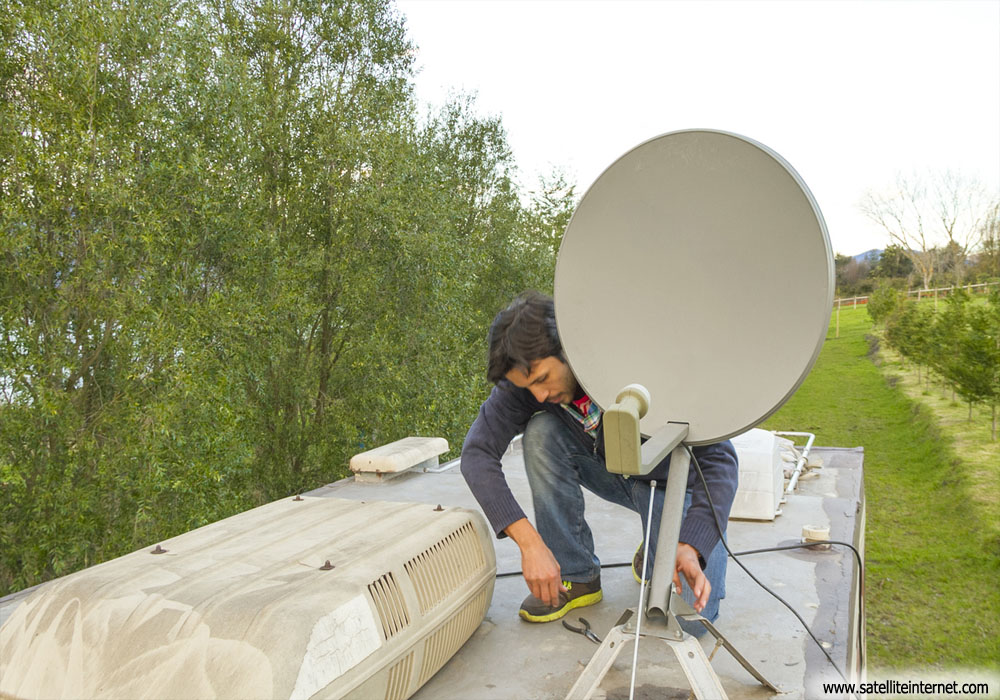Ah, the great outdoors! Campfires out under the stars, picnic food, long walks along wooded trails, nature in all her glory, watching the NFL Game of The Week or the latest movie releases on your 42in flat screen—wait, something is not right here. Rugged pioneer-style camping is fine and great, but if you’ve committed traveling in a Motorhome, 5th Wheel, or large trailer, you’ve already made the commitment to bring the comfort of home with you, so why not watch what you like to watch?
There are several options to view your favorite shows whilst on the road. Just as at your permanent base, you have the option of viewing local or terrestrial originated signals, or satellite service. For many years RV’s came with a pop-up antenna, or it was an add on option, that would allow you to possibly receive local network-affiliated stations, depending on locale, weather, etc. This is still a great option to keep; even you have or will have a satellite receiver, so you can receive local programming if needed.
However, it is important to remember that since 2010 all licensed broadcast providers are required to send their signals in Digital and older antennas, televisions will not receive that signal unless the proper upgrade box or digital-ready television is hooked into the system. If that is questionable you can always consult your RV parts dealer or a reputable electronics retailer.
The best option for receiving television while on the road is by satellite. Long gone are the days of the 12ft monster dish taking up space in your yard. The small digital dishes that are for home use now are perfect for travel.
There are two types available at the present-portable and roof-mounted. All satellite dishes have the same basic components- a parabolic receiving dish to collect and converge the satellite signal, an arm, and an LNB (or feed horn form the old days) that convert the signals into the needed type per your service. There the similarities stop-
Portable- the dish is placed on a tripod or other type of portable stand. Upon arrival, the dish is assembled, situated, cabled, and the proper direction and azimuth are found. The advantages are the dishes are of a lower cost and can be placed anywhere in the site with a clear line of sight; the disadvantages are they are subject to being bumped or tipped over, cabling is external and because of their value, they are ripe for theft.
Roof Top Mounted Dishes come in two types-
Folding Parabolic Dishes- these are just like the portable dishes but are mounted permanently on the roof and probably cabled as well. On arrival unfold and lock in place, locate properly (some dishes have a motorized carriage that will move automatically with the receiver set-up). These are for stationary usage only that is they cannot be used while moving on the road. The current cream of the dish set is a dome dish. These are a mounted small parabolic assemblage inside a plastic housing, maybe 18-24 inches in diameter and less than a foot in height. These domes have a lower profile for less drag in the wind, are weather protected, and some can even be used while traveling because the signal is being constantly adjusted to the correct setting. They do cost more but their advantages should be considered before making a purchase.
Some other points to keep in mind before making a decision:
Most newer RVs are wired internally for cable television- what you need to check on is if your vehicle is wired for satellite as well because there is a difference. Regular television cable, RG59 is not robust enough for satellite signals, which commonly use RG 6. Make sure what your vehicle has within its system. You should avoid at all costs hooking your satellite service into the VCR/Cable wiring. An experienced RV Media-Tech should be consulted if you have questions. Receiving High Definition signals- once you go HD, you never want to go back, or so they say. Receiving HD in your vehicle depends on a couple of things- does the antenna receive HD? All new manufactured dishes should, and many within the last 5 years as well. Does your receiver and service provider give you that option? That is a question for your particular provider. If wiring an older vehicle for new technology, several options can help make a clean install such as wall jacks, installation kits, and signal testers- again, consult your RV dealers for help. To aid in quickly setting up your portable dish, a digital satellite finder and a compass are essential. Saves yelling ‘have we got anything yet?)
Service Provider- this could be a complicated issue and personal at that. With the number of packages and receivers available take some time to shop for the package that best suits your needs- things to look for might be access to local programming, pay-per-view, HD options, DVR service. There are usually hidden costs in certain unbelievable packages, so buyers beware. You should be able to plug your home receiver into your road service with some ease- that is one way to save money, plus it allows you to bring along your home-based DVR with all its stored programming. Your provider can tell you how to set up your particular receiver for your dish option you have and the locale. Another option to save money is to look online for used dishes and receivers- again, your provider should be able to work with you to make these options work.
Turning your traveling vehicle into a mobile road-based media center is not that complicated and with a little research, knowledge of your vehicle, and good consultant to advise, choosing a satellite dish can be an easy decision. Popcorn is optional!









